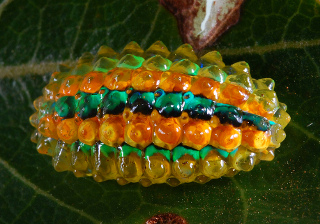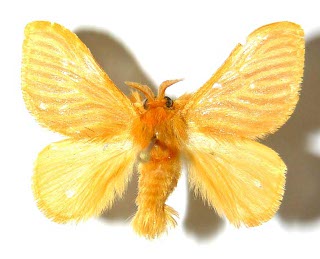Dalceridae jewel caterpillars
Community and Forum → Blog → Dalceridae jewel caterpillars
Lev Bely, 14.05.2012 22:32

Lately the web was charmed with photos of the amazing jewel caterpillar looking like a juicy, translucent, gelatinous gummy bear. One to be blamed is Gerardo Aizpuru, a scuba instructor and amateur wildlife photographer, who shot this caterpillar on a mangrove tree leaf near Cancun, Mexico. He uploaded the pictures on the Project Noah website, a wild nature photos user-created database, where users identified the caterpillar as Acraga coa moth of Dalceridae family.
Hard to say whether Aizpuru's caterpillar is Acraga coa indeed, but it's likely to belong to Dalceridae family. There are already 84 species identified within the family where larvae are also called “slug caterpillars” as they are really gooey. If you browse pictures of Dalceridae caterpillars, you'll see that all of them yet variously colored and have different patterns, look like a plumpy gelatinous ball covered with gumdrop spines. Though Dalceridae caterpillars are colored as bright as many of poisonous caterpillars and other animals whose aggressive colors meant to put predators off, yet they have not been noticed to be whatsoever toxic or something of the kind. Daniel Janzen, a biologist at the University of Pennsylvania who would raise Dalceridae in artificial conditions, says that although the larvae tend to be bright and conspicuous and spend a lot of time walking on the tops of leaves — as though they did not fear birds and other predators — he has no evidence that Dalceridae are poisonous and he knows that they do not sting, unlike some of their cousins.

Biologists however tend not to consider those gumdrop spines just decorative things. They noticed that the cones could fall off caterpillars very easily like one may split them off either they could be even accidentally knocked off by an awkward hand movement. Looks similar to lizard demeanor when it throws off its tail as a kind of “bribe” giving to predators. Janzen says this trick might help the larvae escape from hungry insects and birds, but researchers have not yet confirmed this.
Marc Epstein, an insect biosystematist at the California Department of Food & Agriculture, and his colleagues made an experiment with Dalcerides ingenita larvae and ants. They placed caterpillars in glass Petri dishes, then put there few Camponotus floridanus ants. Usually ants either eat off caterpillar or try to feed it, depends on the situation, but in Dalceridae case few of them inspected larvae with their antennas while most just backed off without trying to bite. Those who still dared to take a bite either got stuck in larvae's jelly coat or rapidly pulled away and began to clean their mandibles to get rid of that gunk. Afterwards Epstein arranged few more tests and didn't found any toxic chemicals in that gooey mass suggesting that it deters ants purely because of its stickiness.
So the jewel caterpillar perfectly justifies its name since anyone is welcome to watch but not to touch.
Scientific American, http://blogs.scientificamerican.com
Photo 1: some Dalceridae caterpillar, artour_a, http://blogs.scientificamerican.com
Photo 2: Acraga coa imago, Daniel Janzen, http://blogs.scientificamerican.com
All the rest posts on: curiosity, science, USA
Comments
New comment
Note: you should have a Insecta.pro account to upload new topics and comments. Please, create an account or log in to add comments.
* Our website is multilingual. Some comments have been translated from other languages.
Random species of the website catalog
News
- 02.03.2025: Moscow Insect Fair: New section on the Insecta.pro Website
- 31.12.2024: If you need to upload a lot of photos to Insecta.pro website
- 10.12.2024: Новое поле в «Поиске энтомологов»
New photos (27.03.2025)
Fresh from the community
- 23:09, M. Niobius: Здравствуйте. Тульская область, окт...
- 12:52, L. Bolshakov: Петр, см. там подробности: https://...
- 12:32, P. Khramov: Лавр, источник скиньте, пожалуйста....
Popular insects
Recommended blog topics
- ICZN Election of Commissioners
- Meantime in Japan
- 20th International Insect Fair in Moscow (Russia, October 2023)
- Butterflies of Karura forest, Nairobi, Kenya



























